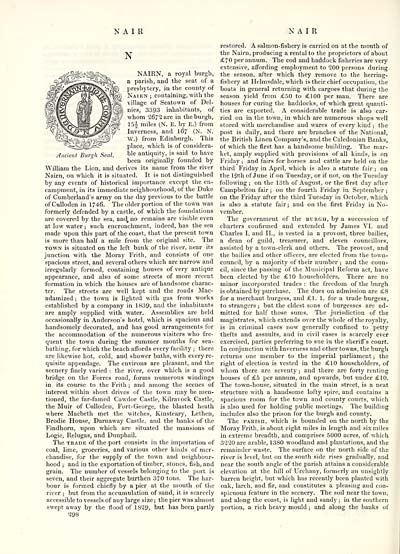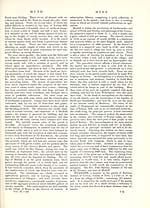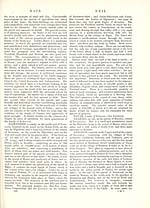Topographical dictionary of Scotland > Volume 2
(306) Page 298
Download files
Complete book:
Individual page:
Thumbnail gallery: Grid view | List view

N A I R
N AI R
Ancient Bursli Seal.
N
NAIRN, a royal burgh,
a parish, and the seat of a
presbytery, in the county of
Nairn ; containing, with the
village of Seatown of Del-
nies, 3393 inhabitants, of
whom 26/2 are in the burgh,
15| miles (N. E. by E.) from
Inverness, and 167 (N. N.
W.) from Edinburgh. This
place, which is of considera-
ble antiquity, is said to have
been originally founded by
William the Lion, and derives its name from the river
Nairn, on which it is situated. It is not distinguished
by any events of historical importance except the en-
campment, in its immediate neighbourhood, of the Duke
of Cumberland's army on the day previous to the battle
of Culloden in 1746. The older portion of the town was
formerly defended by a castle, of which the foundations
are covered by the sea, and, no remains are visible even
at low water ; such encroachment, indeed, has the sea
made upon this part of the coast, that the present town
is more than half a mile from the original site. The
town is situated on the left bank of the river, near its
junction with the Moray Frith, and consists of one
spacious street, and several others which are narrow and
irregularly formed, containing houses of very antique
appearance, and also of some streets of more recent
formation in which the houses are of handsome charac-
ter. The streets are well kept and the roads Mac-
adamized ; the town is lighted with gas from works
established by a company in 1839, and the inhabitants
are amply supplied with water. Assemblies are held
occasionally in Anderson's hotel, which is spacious and
handsomely decorated, and has good arrangements for
the accommodation of the numerous visiters who fre-
quent the town during the summer months for sea-
bathing, for which the beach affords every facility ; there
are likewise hot, cold, and shower baths, with every re-
quisite appendage. The environs are pleasant, and the
scenery finely varied : the river, over which is a good
bridge on the Forres road, forms numerous windings
in its course to the Frith ; and among the scenes of
interest within short drives of the town may be men-
tioned, the far-famed Cawdor Castle, Kilravock Castle,
the Muir of Culloden, Fort- George, the blasted heath
where Macbeth met the witches, Kinsteary, Lethen,
Brodie House, Darnaway Castle, and the banks of the
Findhorn, upon which are situated the mansions of
Logie, Relugas, and Dunphail.
The trade of the port consists in the importation of
coal, lime, groceries, and various other kinds of mer-
chandise, for the supply of the town and neighbour-
hood ; and in the exportation of timber, stones, fish, and
grain. The number of vessels belonging to the port is
seven, and their aggregate burthen 370 tons. The har-
bour is formed chiefly by a pier at the mouth of the
river ; but from the accumulation of sand, it is scarcely
accessible to vessels of any large size ; the pier was almost
swept away by the flood of 1829, but has been partly
298
restored. A salmon-fishery is carried on at the mouth of
the Nairn, producing a rental to the proprietors of about
£70 per annum. The cod and haddock fisheries are very
extensive, affording employment to 200 persons during
the season, after which they remove to the herring-
fishery at Helmsdale, which is their chief occupation, the
boats in general returning with cargoes that during the
season yield from £50 to £100 per man. There are
houses for curing the haddocks, of which great quanti-
ties are exported. A considerable trade is also car-
ried on in the town, in which are numerous shops well
stored with merchandise and wares of every kind ; the
post is daily, and there are branches of the National,
the British Linen Company's, and the Caledonian Banks,
of which the first has a handsome building. The mar-
ket, amply supplied with provisions of all kinds, is on
Friday ; and fairs for horses and cattle are held on the
third Friday in April, which is also a statute fair ; on
the 19th of June if on Tuesday, or if not, on the Tuesday
following ; on the 13th of August, or the first day after
Campbeiton fair ; on the fourth Friday in September ;
on the Friday after the third Tuesday in October, which
is also a statute fair; and on the first Friday in No-
vember.
The government of the burgh, by a succession of
charters confirmed and extended by James VI. and
Charles I. aud II., is vested in a provost, three bailies,
a dean of guild, treasurer, and eleven councillors,
assisted by a town-clerk and others. The provost, and
the bailies and other officers, are elected from the town-
council, by a majority of their number ; and the coun-
cil, since the passing of the Municipal Reform act, have
been elected by the £10 householders. There are no
minor incorporated trades : the freedom of the burgh
is obtained by purchase. The dues on admission are £8
for a merchant burgess, and £1. 1. for a trade burgess,
to strangers ; but the eldest sons of burgesses are ad-
mitted for half those sums. The jurisdiction of the
magistrates, which extends over the whole of the royalty,
is in criminal cases now generally confined to petty
thefts and assaults, and in civil cases is scarcely ever
exercised, parties preferring to sue in the sheriff's court.
In conjunction with Inverness and other towns, the burgh
returns one member to the imperial parliament ; the
right of election is vested in the £10 householders, of
whom there are seventy ; and there are forty renting
houses of £5 per annum, and upwards, but under £10.
The town-house, situated in the main street, is a neat
structure with a handsome lofty spire, and contains a
spacious room for the town and county courts, which
is also used for holding public meetings. The building
includes also the prison for the burgh and county.
The parish, which is bounded on the north by the
Moray Frith, is about eight miles in length and six miles
in extreme breadth, and comprises 5000 acres, of which
3220 are arable, 1380 woodland and plantations, and the
remainder waste. The surface on the north side of the
river is level, but on the south side rises gradually, and
near the south angle of the parish attains a considerable
elevation at the hill of Urchany, formerly an unsightly
barren height, but which has recently been planted with
oak, larch, and fir, and constitutes a pleasing and con-
spicuous feature in the scenery. The soil near the town,
and along the coast, is light and sandy; in the southern
portion, a rich heavy mould ; and along the banks of
N AI R
Ancient Bursli Seal.
N
NAIRN, a royal burgh,
a parish, and the seat of a
presbytery, in the county of
Nairn ; containing, with the
village of Seatown of Del-
nies, 3393 inhabitants, of
whom 26/2 are in the burgh,
15| miles (N. E. by E.) from
Inverness, and 167 (N. N.
W.) from Edinburgh. This
place, which is of considera-
ble antiquity, is said to have
been originally founded by
William the Lion, and derives its name from the river
Nairn, on which it is situated. It is not distinguished
by any events of historical importance except the en-
campment, in its immediate neighbourhood, of the Duke
of Cumberland's army on the day previous to the battle
of Culloden in 1746. The older portion of the town was
formerly defended by a castle, of which the foundations
are covered by the sea, and, no remains are visible even
at low water ; such encroachment, indeed, has the sea
made upon this part of the coast, that the present town
is more than half a mile from the original site. The
town is situated on the left bank of the river, near its
junction with the Moray Frith, and consists of one
spacious street, and several others which are narrow and
irregularly formed, containing houses of very antique
appearance, and also of some streets of more recent
formation in which the houses are of handsome charac-
ter. The streets are well kept and the roads Mac-
adamized ; the town is lighted with gas from works
established by a company in 1839, and the inhabitants
are amply supplied with water. Assemblies are held
occasionally in Anderson's hotel, which is spacious and
handsomely decorated, and has good arrangements for
the accommodation of the numerous visiters who fre-
quent the town during the summer months for sea-
bathing, for which the beach affords every facility ; there
are likewise hot, cold, and shower baths, with every re-
quisite appendage. The environs are pleasant, and the
scenery finely varied : the river, over which is a good
bridge on the Forres road, forms numerous windings
in its course to the Frith ; and among the scenes of
interest within short drives of the town may be men-
tioned, the far-famed Cawdor Castle, Kilravock Castle,
the Muir of Culloden, Fort- George, the blasted heath
where Macbeth met the witches, Kinsteary, Lethen,
Brodie House, Darnaway Castle, and the banks of the
Findhorn, upon which are situated the mansions of
Logie, Relugas, and Dunphail.
The trade of the port consists in the importation of
coal, lime, groceries, and various other kinds of mer-
chandise, for the supply of the town and neighbour-
hood ; and in the exportation of timber, stones, fish, and
grain. The number of vessels belonging to the port is
seven, and their aggregate burthen 370 tons. The har-
bour is formed chiefly by a pier at the mouth of the
river ; but from the accumulation of sand, it is scarcely
accessible to vessels of any large size ; the pier was almost
swept away by the flood of 1829, but has been partly
298
restored. A salmon-fishery is carried on at the mouth of
the Nairn, producing a rental to the proprietors of about
£70 per annum. The cod and haddock fisheries are very
extensive, affording employment to 200 persons during
the season, after which they remove to the herring-
fishery at Helmsdale, which is their chief occupation, the
boats in general returning with cargoes that during the
season yield from £50 to £100 per man. There are
houses for curing the haddocks, of which great quanti-
ties are exported. A considerable trade is also car-
ried on in the town, in which are numerous shops well
stored with merchandise and wares of every kind ; the
post is daily, and there are branches of the National,
the British Linen Company's, and the Caledonian Banks,
of which the first has a handsome building. The mar-
ket, amply supplied with provisions of all kinds, is on
Friday ; and fairs for horses and cattle are held on the
third Friday in April, which is also a statute fair ; on
the 19th of June if on Tuesday, or if not, on the Tuesday
following ; on the 13th of August, or the first day after
Campbeiton fair ; on the fourth Friday in September ;
on the Friday after the third Tuesday in October, which
is also a statute fair; and on the first Friday in No-
vember.
The government of the burgh, by a succession of
charters confirmed and extended by James VI. and
Charles I. aud II., is vested in a provost, three bailies,
a dean of guild, treasurer, and eleven councillors,
assisted by a town-clerk and others. The provost, and
the bailies and other officers, are elected from the town-
council, by a majority of their number ; and the coun-
cil, since the passing of the Municipal Reform act, have
been elected by the £10 householders. There are no
minor incorporated trades : the freedom of the burgh
is obtained by purchase. The dues on admission are £8
for a merchant burgess, and £1. 1. for a trade burgess,
to strangers ; but the eldest sons of burgesses are ad-
mitted for half those sums. The jurisdiction of the
magistrates, which extends over the whole of the royalty,
is in criminal cases now generally confined to petty
thefts and assaults, and in civil cases is scarcely ever
exercised, parties preferring to sue in the sheriff's court.
In conjunction with Inverness and other towns, the burgh
returns one member to the imperial parliament ; the
right of election is vested in the £10 householders, of
whom there are seventy ; and there are forty renting
houses of £5 per annum, and upwards, but under £10.
The town-house, situated in the main street, is a neat
structure with a handsome lofty spire, and contains a
spacious room for the town and county courts, which
is also used for holding public meetings. The building
includes also the prison for the burgh and county.
The parish, which is bounded on the north by the
Moray Frith, is about eight miles in length and six miles
in extreme breadth, and comprises 5000 acres, of which
3220 are arable, 1380 woodland and plantations, and the
remainder waste. The surface on the north side of the
river is level, but on the south side rises gradually, and
near the south angle of the parish attains a considerable
elevation at the hill of Urchany, formerly an unsightly
barren height, but which has recently been planted with
oak, larch, and fir, and constitutes a pleasing and con-
spicuous feature in the scenery. The soil near the town,
and along the coast, is light and sandy; in the southern
portion, a rich heavy mould ; and along the banks of
Set display mode to: Large image | Transcription
Images and transcriptions on this page, including medium image downloads, may be used under the Creative Commons Attribution 4.0 International Licence unless otherwise stated. ![]()
| Gazetteers of Scotland, 1803-1901 > Topographical dictionary of Scotland > Volume 2 > (306) Page 298 |
|---|
| Permanent URL | https://digital.nls.uk/97364802 |
|---|
| Description | Volume II: From Keanlochbervie to Zetland. |
|---|---|
| Attribution and copyright: |
|

